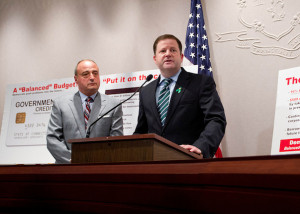With a 19-17 vote, state senators gave final approval last week to a $37.6 billion budget for Connecticut”™s 2014 and 2015 fiscal years.
The budget ”” which includes at least three tax extensions and an expansion on gambling ”” invests in education and maintains aid to municipalities and the growing demand for social services. It ultimately did not include $6.4 billion in federal Medicaid funds, which would have put total spending at around $44 billion for the two years.
The budget increases state spending by 8.6 percent, according to Budget Director Ben Barnes. The state fiscal calendar runs from July 1 through June 30.
“Of course, no budget is perfect and this budget required many tough cuts, many tough choices and hard compromises,” said Gov. Dannel P. Malloy in a statement after the House passed the budget June 2. “We still have a long way to go. But this budget shows that we”™ve got our priorities straight and we are determined to keep Connecticut moving forward.”
Senators approved the budget just before 10 p.m. on June 3, one day after members of the House approved the budget by a 95-48 vote following a debate that stretched into the early hours of June 2.
No Republicans from either house voted in favor of the budget, and three Senate Democrats joined their counterparts in dissenting. Senate approval came by a razor-thin margin, with 19 “yeas” required for passage.
Among the more controversial aspects of the budget debate was the question of whether $6.4 billion in federal Medicaid assistance should count against the state”™s constitutional spending cap.
Historically, federal assistance has counted toward the cap, which is based on personal income growth or the rate of inflation. However, Malloy and Democratic legislators say the previous interpretation of the law has forced the state to limit its federal assistance and underfund other budget items for 20 years.
“Exempting the first year of fully funded federal programs from the cap, as the governor proposes, is a common sense fix,” Matthew Santacroce, policy analyst for Connecticut Voices for Children, wrote in a May analysis. It “ensures the cap does what it was originally meant to do ”” limit state spending, not federal spending.”

Ultimately the budget that passed allows the state to exclude the $6.4 billion in funds. However, Republican leaders, including House Minority Leader Larry Cafero, said the maneuver is a fiscal gimmick that allows the budget to exceed the cap, a violation of the state constitution.
Without shifting Medicaid assistance outside of the cap, spending would have increased 10 percent. However, Connecticut now joins every other state in the nation in determining how the federal assistance is counted, according to state Senate President Pro Tempore Donald Williams, a Brooklyn Democrat.
Though Malloy says the budget includes no new taxes, policy changes are expected to increase revenues by $740.3 million over the biennium. Many legislators and organizations have criticized the changes as one-shot revenues that do not solve the state”™s fiscal problems.
Roughly $173 million will be secured through extensions on an electricity generation tax, the corporate income tax and a cap adjustment for tax credits related to insurance premiums. The General Fund will see a $76 million one-time transfer from the Special Transportation Fund and a $165 million surplus from the current fiscal year will also be used to fund the upcoming budget.
Additionally, the state plans to expand its gambling program by installing several electronic Keno games in bars across the state, pending Indian tribe negotiations. The proposal is expected to bring in about $30.8 million in revenue over the next two years.
Despite protests, the budget also includes $550 million in cuts to hospitals, achieved primarily through the hospital provider tax, which the state no longer plans to return to the hospitals.
Though officials at the Connecticut Hospital Association (CHA) contend the cuts will have devastating consequences for patients, jobs, hospital services and programs, the group was unsuccessful in convincing legislators to restore its funding after Malloy proposed the cuts in his February budget proposal.
“This is a blow to every hospital, patient, caregiver, and community in Connecticut,” said Jennifer Jackson, CHA CEO, in a release. “We feel strongly that hospitals and the administration can and should come together to find solutions that maximize federal funding, reduce costs for patients, and protect vital healthcare services.”
The amount represents an annual reduction of about15 percent, according to state officials.



















